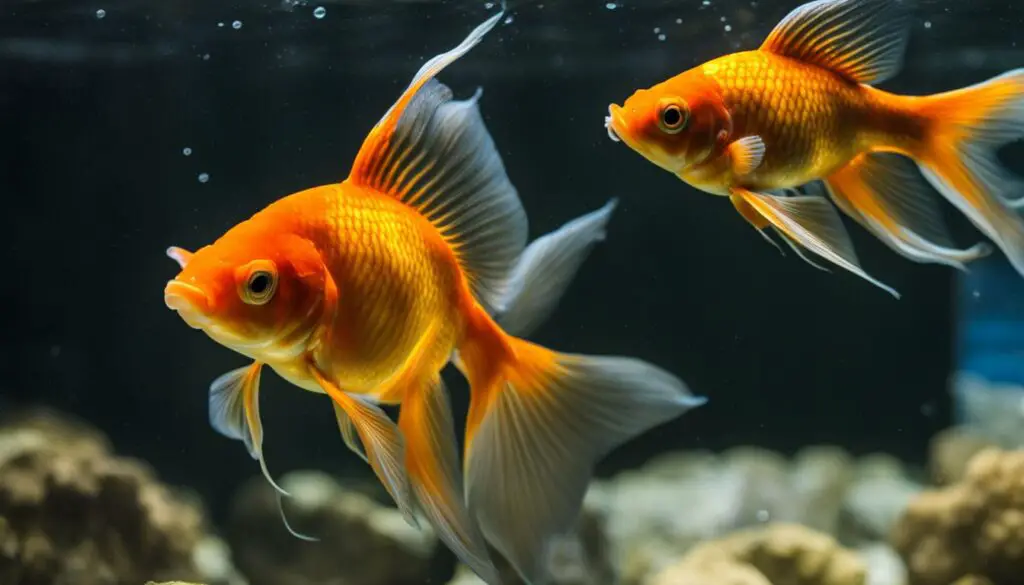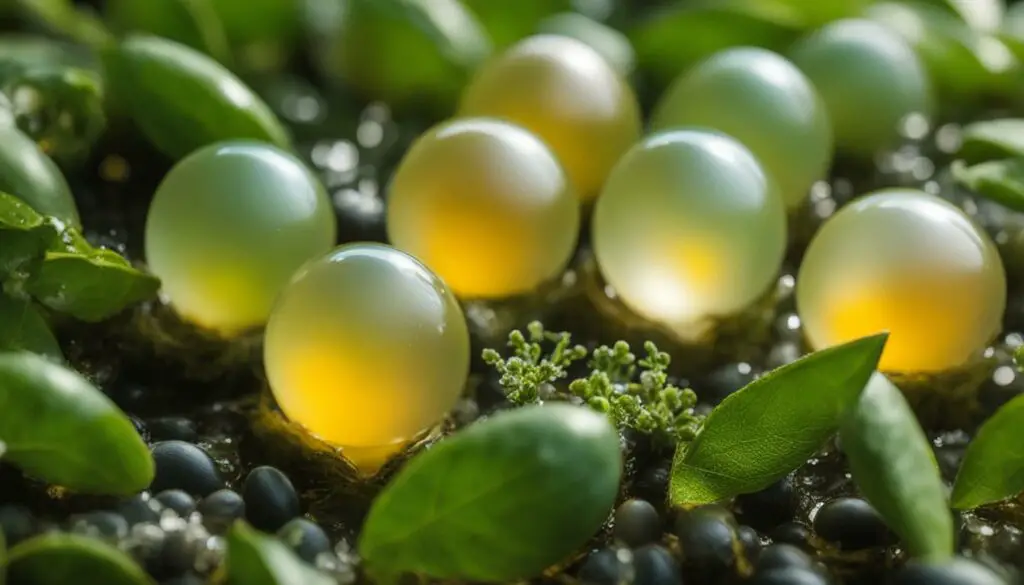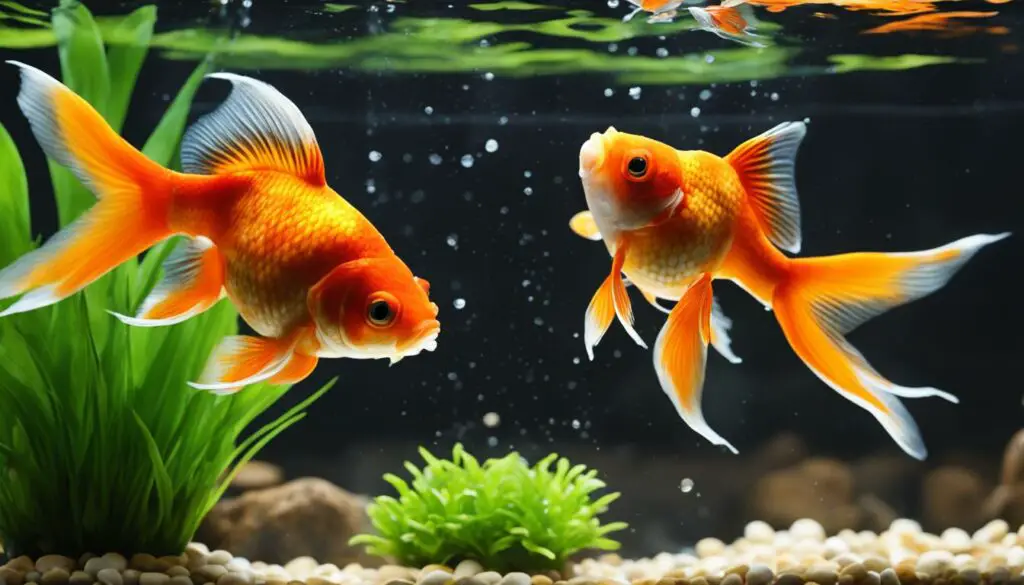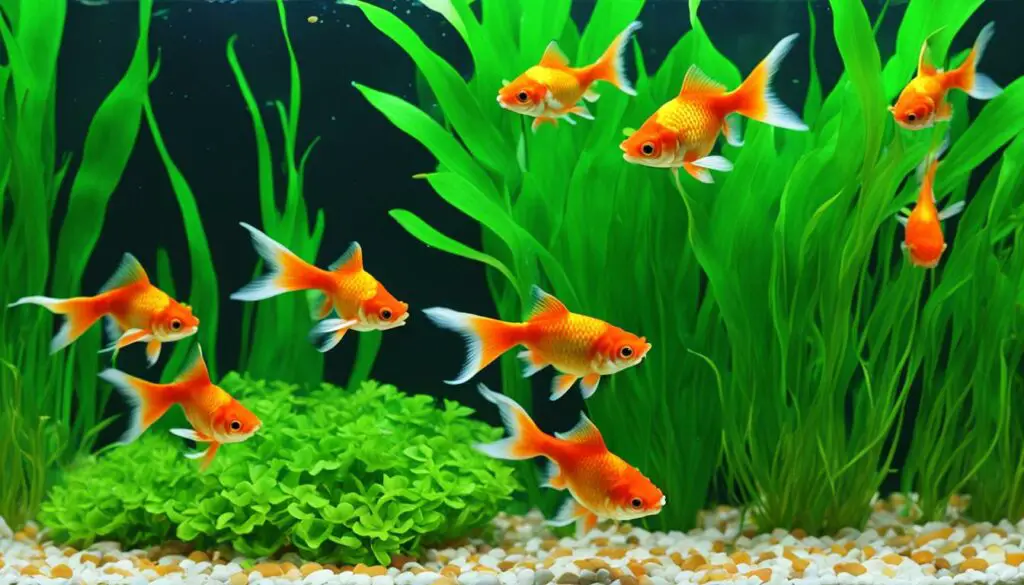Last Updated on 1 year by admin
Goldfish breeding is a fascinating topic that many people are interested in. Goldfish are known for their vibrant colors and unique personalities. In this article, we will explore the breeding habits of goldfish and answer the question of whether or not they lay eggs. We will also provide insights and tips on supporting their reproductive cycle.
Key Takeaways:
- Goldfish are egg-laying fish and reproduce through spawning.
- During the breeding season, male goldfish court females by displaying vibrant colors and fins.
- The female releases eggs into the water, and the male fertilizes them with his milt.
- Proper water quality management is crucial for the development of goldfish eggs and fry.
- A suitable breeding tank setup includes a minimum tank capacity of 20 gallons and a filtration system.
The Mating Process of Goldfish

Goldfish engage in a series of courtship rituals before mating. During the breeding season, male goldfish actively seek out female goldfish to mate with. They perform courtship displays, such as chasing the female and flaunting their colors and fins. Males also release pheromones to attract females. Once a male has successfully wooed a female, the spawning process begins. The female releases eggs into the water, and the male fertilizes them with his milt. This typically happens in the spring when the days get longer and the water temperatures rise.
Goldfish courtship behavior is a fascinating display of colors and courtship dance. The male’s pursuit of the female showcases their determination to secure a mate. The female’s release of eggs and the male’s ability to fertilize them ensures the continuation of their species. Understanding this spawning method is crucial for goldfish breeders to encourage successful egg production.
The Development of Goldfish Eggs

Once the goldfish eggs are fertilized, they begin their journey towards becoming healthy and vibrant fry. In just 48 to 72 hours, these eggs transform into baby goldfish, commonly known as fry. This remarkable process showcases the resilience and potential of these tiny aquatic creatures.
During this critical period of goldfish egg development, it is vital to prioritize water quality maintenance. Even the slightest levels of pollutants or imbalances in the water can have detrimental effects on the developing fry. To ensure the best chance of survival, proper purification and water quality management are essential.
By diligently monitoring and maintaining water quality parameters such as pH levels, ammonia, nitrite, and temperature, breeders can create a favorable environment for the eggs and fry. It is important to note that goldfish fry are delicate and susceptible to environmental changes, so maintaining stable and optimal water conditions is of utmost importance.
“Good water quality is the key to successful goldfish egg development and fry survival.”
| Water Quality Parameters | Ideal Range |
|---|---|
| pH | 7.2-7.6 |
| Ammonia | 0 ppm |
| Nitrite | 0 ppm |
| Temperature | 72-78°F (22-26°C) |
Regular water testing, partial water changes, and the use of filtration systems can all contribute to maintaining a healthy aquatic environment for goldfish eggs and fry. Investing time and effort in water quality management will greatly increase the chances of successful goldfish breeding and fry development.
As the goldfish eggs continue to develop and hatch, the excitement builds among breeders. It is an awe-inspiring moment to witness new life unfold and witness the tiny fry emerge. With proper care and attention to water quality, these newly hatched goldfish fry have the potential to grow into beautiful adult goldfish.
Setting Up a Breeding Tank for Goldfish
Creating the right environment is crucial when it comes to breeding goldfish. The ideal breeding tank setup involves several key factors to ensure the health and success of your goldfish breeding endeavors.
First and foremost, you’ll need a tank large enough to provide ample swimming space for the goldfish and allow for their development. A minimum tank capacity of 20 gallons is recommended to accommodate the breeding pair comfortably.
Additionally, installing a reliable filter system is essential for maintaining clean water in the breeding tank. The filter will help remove harmful substances, promote better oxygenation, and maintain overall water quality, which is crucial for the well-being of the breeding goldfish.
Creating a suitable breeding environment can be achieved by incorporating plants into the tank. Both real and artificial plants can provide hiding spots and create a more natural feel for the goldfish. The presence of plants can also encourage the goldfish to exhibit their natural breeding behaviors.
To ensure optimal conditions for breeding, regular monitoring and maintenance of water quality are essential. It is recommended to regularly check and manage pH levels, ammonia and nitrite levels, and perform partial water changes as needed. This attention to water quality management contributes to the success of goldfish breeding.
In summary, setting up a breeding tank for goldfish requires a minimum tank size of 20 gallons, the installation of a reliable filter system, and the inclusion of plants to create a comfortable breeding environment. Regular monitoring and maintenance of water quality are also crucial factors in supporting successful goldfish breeding.
Inducing Goldfish to Lay Eggs

Goldfish breeding can be induced using different methods. The goal is to create a conducive environment that stimulates egg production in female goldfish. Here, we will explore both comfortable and uncomfortable methods for inducing egg production in goldfish. It is important to note that these methods should only be used on mature females and proper monitoring and care should be taken during the process.
Comfortable Methods:
To induce egg production comfortably, it is crucial to provide a stable and suitable environment for your goldfish. Here are some recommended methods:
- Stable Environment: Ensure your goldfish are housed in a well-maintained aquarium with mature filtration. This creates a stable and balanced habitat for the fish, promoting optimal health and reproductive activities.
- Pairing with Suitable Mates: Choose compatible mates for your goldfish breeding pair. Consider factors such as size, age, and breed compatibility. This increases the chances of successful breeding and reduces stress for the fish involved.
- Mimicking Natural Conditions: Create a natural-like setting in the breeding tank by introducing live or artificial plants. Provide sufficient sunlight or simulate natural lighting conditions. These elements can provide cues for the goldfish to initiate the breeding process.
Uncomfortable Methods:
In some cases, uncomfortable methods may be employed to induce egg production in goldfish. These should be used with caution and only as a last resort. Here are some examples:
- Water Changes: Gradual and controlled changes in water parameters, such as temperature or pH, can mimic natural breeding conditions. However, sudden or extreme changes should be avoided as they can cause stress and harm to the fish.
- Altering the Environment: Relocating the goldfish from an indoor tank to an outdoor pond or vice versa can sometimes trigger breeding behavior. The change in environment can stimulate reproductive instincts. However, proper acclimation and transition must be carried out to minimize stress and ensure the well-being of the fish.
It is essential to approach these uncomfortable methods with care and monitor the goldfish closely throughout the process. The focus should always be on the health and well-being of the fish, ensuring they are not subjected to unnecessary stress or discomfort.
| Comfortable Methods for Inducing Egg Production | Uncomfortable Methods for Inducing Egg Production |
|---|---|
| Stable environment with mature filtration | Water changes |
| Pairing goldfish with suitable mates | Altering the environment |
| Mimicking natural conditions (plants, sunlight) |
By understanding the methods for inducing egg production in goldfish, breeders have the opportunity to support and facilitate successful breeding in their tanks. Whether employing comfortable or uncomfortable methods, it is crucial to prioritize the well-being and health of the fish throughout the breeding process.
Dealing with Difficult Goldfish Breeders

While goldfish breeding can be a rewarding experience, some goldfish may prove more challenging to induce to breed than others. If you find that your goldfish are unresponsive to comfortable induction methods, there are more intense techniques that can be tried to stimulate their breeding instincts.
One approach is to mimic seasonal changes in their environment. By adjusting factors such as temperature, lighting, and water conditions, you can create conditions that closely resemble the natural breeding season for goldfish. This may help trigger their reproductive instincts and encourage breeding.
Another method is to consider the water hardness. Lowering the water hardness within a suitable range can sometimes encourage goldfish to breed. This can be achieved by using water conditioners or adjusting the mineral content of the water.
However, if all else fails, patience can be the key to successfully breeding difficult goldfish. While most goldfish become productive at around four months of age, there are individuals that may not start breeding until later. It’s important to consider the unique characteristics of each fish and adapt the breeding strategy accordingly.
Remember, breeding goldfish requires a combination of knowledge, experience, and adaptability. By observing their behavior, adjusting environmental conditions, and experimenting with different approaches, you can increase your chances of success in inducing breeding in difficult goldfish. Keep in mind that each goldfish is unique, and what works for one may not work for another.
By exercising patience and being attentive to the needs of your goldfish, you can navigate the challenges of breeding difficult breeders and ultimately enjoy the fulfillment of seeing new life come into the world.
Stay tuned for the next section, where we will provide a comprehensive conclusion to our exploration of goldfish breeding, summarizing the key insights and tips shared throughout this article.
Conclusion

Breeding goldfish can be a truly rewarding and exciting experience for aquatic enthusiasts. By gaining a thorough understanding of their mating process and implementing appropriate breeding strategies, you can significantly enhance the chances of successful egg production and fry development. Additionally, providing a suitable breeding tank setup and diligently managing water quality are vital to support the reproductive cycle of these beautiful creatures.
Throughout this article, we have provided valuable insights and expert tips on goldfish breeding. By following these recommendations, you can deepen your knowledge and appreciation for the intricacies of goldfish reproduction. Whether you are a novice breeder or an experienced aquarist, the information shared here will undoubtedly contribute to your success in this fascinating hobby.
Remember, creating a proper breeding environment is crucial. Be sure to set up a spacious tank with adequate filtration and consider incorporating plants to mimic natural conditions. Regularly monitor water quality, including pH levels and ammonia/nitrite concentrations, and perform routine partial water changes to maintain optimal conditions for your goldfish.
The wonder of goldfish breeding lies not only in the captivating journey of egg development, but also in witnessing the incredible growth and transformation of the fry. Observing these young goldfish flourish under your care is truly a remarkable experience.
To conclude, we hope that this comprehensive guide has provided you with valuable insights into goldfish breeding. Armed with this knowledge and the passion for these stunning aquatic creatures, you can embark on your own goldfish breeding journey and relish in the wonder of new life in your aquarium.
| Key Takeaways |
|---|
| 1. Understand the mating process: Familiarize yourself with the courtship behaviors and spawning methods of goldfish to increase breeding success. |
| 2. Set up a suitable breeding tank: Provide a spacious tank with proper filtration and mimic natural conditions for optimal egg production and fry development. |
| 3. Manage water quality: Regularly monitor and maintain water quality parameters, such as pH, ammonia, and nitrite levels, to ensure a healthy breeding environment. |
| 4. Follow expert tips and insights: Implement the strategies and recommendations shared in this article to enhance your goldfish breeding success rate. |
Additional Insights on Goldfish Breeding
In addition to the general information on goldfish breeding, this article also provides additional insights on specific goldfish breeding projects. These include ranchu breeding, blue oranda breeding, and insights on inducing egg production in different female goldfish types. The breeding projects discussed in this section offer a deeper understanding of goldfish breeding and the challenges breeders may face.
When it comes to goldfish breeding projects, one popular variety is ranchu breeding. Ranchu goldfish are known for their distinct appearance, with a rounded body and a prominent headgrowth. Breeding ranchu goldfish requires careful selection of compatible mates to ensure desirable traits are passed down to the offspring. Furthermore, maintaining optimal water quality and providing a suitable breeding environment are essential for successful ranchu breeding projects.
Image:
Another fascinating goldfish breeding project is blue oranda breeding. Oranda goldfish are characterized by their prominent headgrowth and the availability of different color variations. Breeding blue orandas involves selecting and pairing individuals with the desired blue coloration. The breeding process requires careful management of water quality parameters and maintaining environmental conditions conducive to healthy spawning and fry development.
Here is a table showcasing some key differences between ranchu and blue oranda goldfish:
| Ranchu Goldfish | Blue Oranda Goldfish |
|---|---|
| Distinct rounded body shape | Prominent headgrowth |
| Available in various color variations | Blue coloration is desired |
| Requires careful pairing for breeding | Selective breeding for desired traits |
Table: Comparison between Ranchu and Blue Oranda Goldfish
Inducing egg production in different female goldfish types is another aspect covered in this section. Female goldfish can exhibit varying levels of egg production capacity, which may influence the success of breeding projects. Understanding how to stimulate egg production in different female goldfish types allows breeders to optimize their breeding strategies and improve the chances of successful egg fertilization and fry development.
Overall, these additional insights on goldfish breeding projects provide valuable information for both novice and experienced breeders. Whether you’re interested in ranchu breeding, blue oranda breeding, or enhancing egg production in specific goldfish types, understanding the unique challenges and requirements of these projects is essential for successful goldfish breeding.
Tips and Strategies for Goldfish Breeding
Successful goldfish breeding requires careful planning and implementation of effective strategies. Whether you are a novice or experienced breeder, these tips will help you improve your breeding success and increase the chances of producing healthy offspring.
Firstly, it is important to categorize female goldfish based on their egg production capacity. Some females may produce a higher quantity of eggs compared to others. By identifying high producing females, you can prioritize them for breeding and increase the chances of a successful spawn.
Secondly, differentiate between comfortable and uncomfortable induction methods. Comfortable methods, such as creating a stable and suitable breeding environment, are preferred as they mimic the natural conditions goldfish prefer for breeding. Uncomfortable methods, such as drastic changes in water parameters, should only be used as a last resort and with caution to avoid unnecessary stress on the fish.
Lastly, patience is key when breeding difficult fish. Some goldfish may take longer to start breeding or might require more intensive techniques. Be patient and adapt your breeding strategy based on the individual characteristics of each fish. With time, you will likely see increased breeding success and satisfaction in your goldfish breeding endeavors.
FAQ
Do goldfish lay eggs?
Yes, goldfish lay eggs when they are ready to reproduce.
What are the breeding habits of goldfish?
Goldfish engage in courtship rituals before mating. Males actively seek out females and perform courtship displays to attract them.
How do goldfish reproduce?
Goldfish reproduce through a process called spawning, where the female releases eggs into the water and the male fertilizes them with his milt.
How long does it take for goldfish eggs to develop?
Goldfish eggs usually hatch into baby fish, known as fry, within 48 to 72 hours after fertilization.
What is important for the development of goldfish eggs?
Maintaining good water quality is crucial for the development of goldfish eggs. Even small levels of pollutants can be fatal to the developing fry.
How should I set up a breeding tank for goldfish?
It is recommended to have a minimum tank capacity of 20 gallons and install a filter to keep the water clean. Adding plants can create a suitable breeding environment.
How can goldfish be induced to lay eggs?
Comfortable methods such as providing a stable environment and suitable mates can be used to induce goldfish to breed. Uncomfortable methods like changing water or moving the fish can also be used.
What should I do if my goldfish is a difficult breeder?
If a goldfish is unresponsive to comfortable induction methods, more intense techniques can be tried. These include mimicking seasonal changes or lowering water hardness. It is also important to be patient.
What are some additional insights on goldfish breeding?
This article provides insights on specific goldfish breeding projects such as ranchu breeding and blue oranda breeding.
What are some tips and strategies for successful goldfish breeding?
Tips and strategies include categorizing female fish based on their egg production, differentiating between comfortable and uncomfortable induction methods, and practicing patience when breeding difficult fish.
Source Links
- https://hermantogoldfish.com/category/breeding-technique/
- https://fishlab.com/how-do-goldfish-mate/
- https://hermantogoldfish.com/category/the-diary-of-a-goldfish-breeder-2022/

